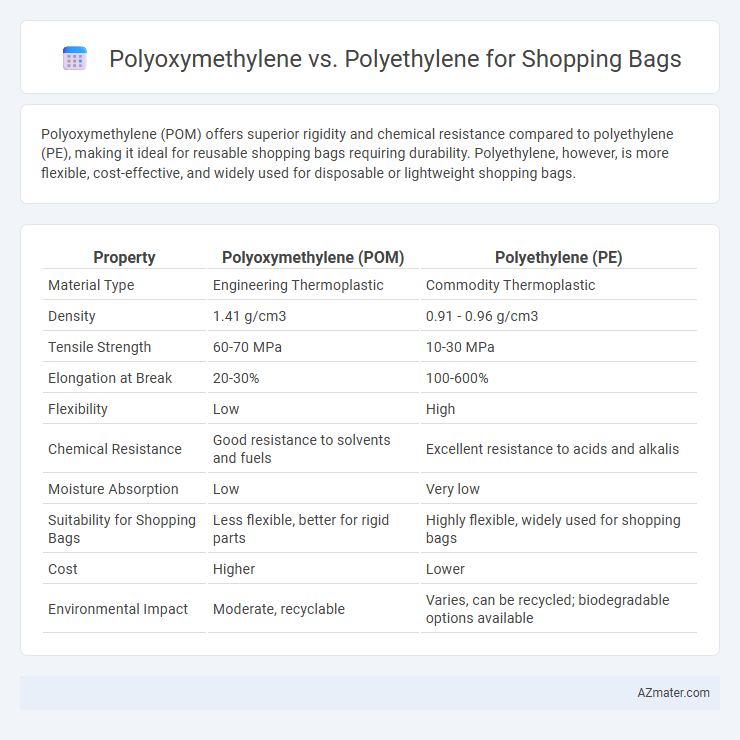Polyoxymethylene (POM) offers superior rigidity and chemical resistance compared to polyethylene (PE), making it ideal for reusable shopping bags requiring durability. Polyethylene, however, is more flexible, cost-effective, and widely used for disposable or lightweight shopping bags.
Table of Comparison
| Property | Polyoxymethylene (POM) | Polyethylene (PE) |
|---|---|---|
| Material Type | Engineering Thermoplastic | Commodity Thermoplastic |
| Density | 1.41 g/cm3 | 0.91 - 0.96 g/cm3 |
| Tensile Strength | 60-70 MPa | 10-30 MPa |
| Elongation at Break | 20-30% | 100-600% |
| Flexibility | Low | High |
| Chemical Resistance | Good resistance to solvents and fuels | Excellent resistance to acids and alkalis |
| Moisture Absorption | Low | Very low |
| Suitability for Shopping Bags | Less flexible, better for rigid parts | Highly flexible, widely used for shopping bags |
| Cost | Higher | Lower |
| Environmental Impact | Moderate, recyclable | Varies, can be recycled; biodegradable options available |
Introduction to Polyoxymethylene and Polyethylene
Polyoxymethylene (POM) is an engineering thermoplastic known for its high stiffness, low friction, and excellent dimensional stability, making it suitable for durable components but less common for flexible applications like shopping bags. Polyethylene (PE), particularly low-density polyethylene (LDPE) and high-density polyethylene (HDPE), dominates the shopping bag market due to its flexibility, tear resistance, and lightweight nature. The chemical structure of POM provides rigidity from its acetal groups, while polyethylene's simple hydrocarbon chains offer versatile mechanical properties tailored for cost-effective and recyclable plastic bags.
Chemical Structure and Material Properties
Polyoxymethylene (POM) features a highly crystalline structure with repeating -CH2-O- units, offering exceptional stiffness, low friction, and high resistance to solvents and chemicals compared to Polyethylene (PE), which consists of long hydrocarbon chains with varying branching that influence its density and flexibility. POM's tight molecular arrangement provides superior mechanical strength and dimensional stability, making it less prone to deformation under stress, whereas PE, particularly Low-Density Polyethylene (LDPE), delivers greater elasticity and impact resistance but lower tensile strength. In shopping bag applications, PE's lightweight, flexibility, and ease of processing often outweigh POM's mechanical advantages, while POM finds niche uses where durability and chemical resistance are critical.
Mechanical Strength Comparison
Polyoxymethylene (POM) exhibits superior mechanical strength compared to polyethylene (PE) in shopping bags, offering higher tensile strength and stiffness for enhanced durability. POM's crystalline structure provides better resistance to wear and tear, making it ideal for heavier loads and repeated use. Polyethylene, while more flexible and cost-effective, generally has lower mechanical strength and is prone to stretching and tearing under stress.
Durability and Wear Resistance
Polyoxymethylene (POM) offers superior durability and wear resistance compared to polyethylene (PE) when used for shopping bags, making it ideal for repeated use and heavy loads. POM's high tensile strength and excellent abrasion resistance allow it to withstand rough handling and resist tearing better than the more flexible but less robust polyethylene. While polyethylene is cost-effective and lightweight, polyoxymethylene provides enhanced longevity and structural integrity in demanding shopping bag applications.
Environmental Impact and Biodegradability
Polyoxymethylene (POM) offers superior mechanical strength compared to polyethylene (PE), but both materials pose significant environmental challenges due to their resistance to biodegradation. Polyethylene, especially low-density polyethylene (LDPE), is widely used for shopping bags but can persist in the environment for hundreds of years, contributing to plastic pollution and microplastic formation. In contrast, POM's complex chemical structure further hinders microbial breakdown, leading to prolonged environmental persistence and complicating recycling efforts, making sustainable alternatives or biodegradable polymers more favorable for reducing ecological impact.
Manufacturing Process for Shopping Bags
Polyethylene is predominantly used in shopping bag manufacturing through blown or cast film extrusion, offering flexibility and cost efficiency with simple processing. Polyoxymethylene, rarely used for shopping bags, requires precision injection molding or extrusion, involving higher production complexity and costs due to its crystalline structure. The choice of polyethylene ensures high-volume, scalable production, whereas polyoxymethylene's manufacturing process is less suited for thin, flexible films typical of shopping bags.
Cost Efficiency and Market Availability
Polyethylene dominates the shopping bag market due to its low production cost and wide availability, making it the most cost-efficient choice for manufacturers. Polyoxymethylene, while offering higher mechanical strength and durability, is significantly more expensive and less common in retail packaging applications. The cost efficiency and extensive supply chain infrastructure of polyethylene ensure its continued preference over polyoxymethylene in the shopping bag industry.
User Safety and Food Contact Compliance
Polyoxymethylene (POM) offers superior chemical resistance and structural stability compared to polyethylene (PE), making it less likely to degrade or transfer harmful substances during food contact. PE is widely approved for food packaging due to its inertness and compliance with FDA and EFSA regulations, ensuring consumer safety in shopping bags used for food items. User safety favors PE for direct food contact applications, while POM is better suited for durable, non-food-related packaging requiring higher mechanical strength.
Applications Beyond Shopping Bags
Polyoxymethylene (POM) offers superior mechanical strength and chemical resistance, making it ideal for precision components in automotive and electrical industries. Polyethylene (PE), with its flexibility and moisture barrier properties, is widely used in food packaging, agricultural films, and medical product packaging beyond shopping bags. Both polymers serve versatile roles, with POM favored for durability-driven applications and PE for cost-effective, flexible packaging solutions.
Summary: Choosing the Right Polymer for Shopping Bags
Polyethylene remains the preferred polymer for shopping bags due to its excellent flexibility, lightweight nature, and cost-effectiveness, ensuring durability and ease of use. Polyoxymethylene, while offering higher stiffness and impact resistance, is less suitable for flexible bag applications due to its brittleness and higher production costs. Selecting polyethylene optimizes performance and affordability, making it the ideal choice for everyday shopping bags.

Infographic: Polyoxymethylene vs Polyethylene for Shopping Bag
 azmater.com
azmater.com